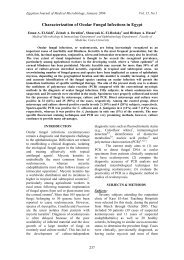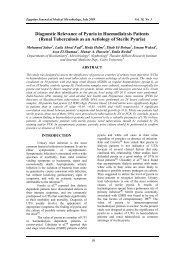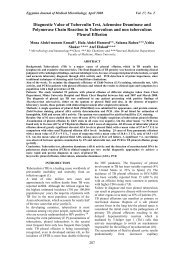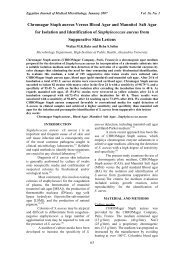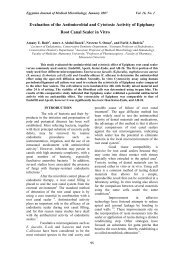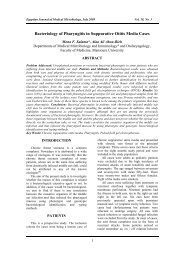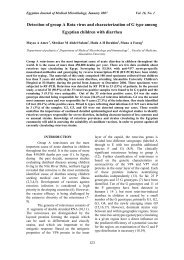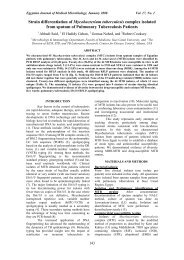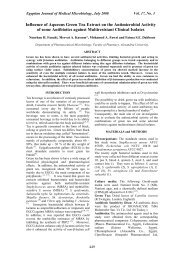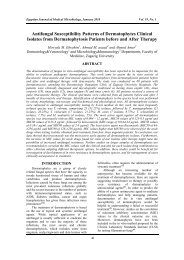Correlation Between Female Genital Tract Levels of Interleukin-6 ...
Correlation Between Female Genital Tract Levels of Interleukin-6 ...
Correlation Between Female Genital Tract Levels of Interleukin-6 ...
You also want an ePaper? Increase the reach of your titles
YUMPU automatically turns print PDFs into web optimized ePapers that Google loves.
Egyptian Journal <strong>of</strong> Medical Microbiology, October 2008<br />
Vol. 17, No. 4<br />
<strong>Correlation</strong> <strong>Between</strong> <strong>Female</strong> <strong>Genital</strong> <strong>Tract</strong> <strong>Levels</strong> <strong>of</strong> <strong>Interleukin</strong>-6 and<br />
<strong>Interleukin</strong>-8 in Recurrent Miscarriage Associated with Bacterial<br />
Vaginosis<br />
Sahar Taher 1 and Mohamed El-Negeri 2<br />
(1) Department <strong>of</strong> Medical Microbiology and Immunology, Faculty <strong>of</strong> Medicine, Mansoura<br />
University. (2) Department <strong>of</strong> Obstetric and Gynecology, Faculty <strong>of</strong> Medicine, Mansoura<br />
University.<br />
ABSTRACT:<br />
Bacterial vaginosis (BV) is the most common cause <strong>of</strong> abnormal vaginal discharge among women in childbearing period. It<br />
develops when vaginal lactobacilli are replaced by an overgrowth <strong>of</strong> Gardnerella vaginalis, anaerobes, and mycoplasma. BV<br />
is associated with subclinical endometritis and may be correlated with recurrent miscarriages. Miscarriage refers to the loss a<br />
pregnancy before 24 weeks. It was reported that there is a relation between IL-6 and IL-8 in cervical and amniotic fluid and<br />
microbial invasion <strong>of</strong> chorioamniotic membranes. Our aim is to determine the value <strong>of</strong> genital tract levels <strong>of</strong> IL-6 and IL-8 in<br />
women with recurrent miscarriages in the presence or absence <strong>of</strong> BV. The present study included 94 women, 54 <strong>of</strong> them had<br />
history <strong>of</strong> recurrent miscarriage (patients group) and 40 females with normal pregnancy (control group). Samples were<br />
collected by vaginal swabs and cervicovaginal lavages(CVL) and examined physically, microscopically and were graded by<br />
Gram stain for BV, cytokine levels measured by ELISA kits.<br />
There was an increase in frequency <strong>of</strong> miscarriage with age. BV was detected in 37% <strong>of</strong> patients group and in 20% <strong>of</strong><br />
control group. Gardnerella vaginalis was found in 33% and 15% <strong>of</strong> patients and control group respectively. When<br />
comparing patients group versus control group both cytokines levels were elevated, the mean (± SD) <strong>of</strong> IL-6 was<br />
66.88±60.00 vs 11.14 ±13.69 pg/ml and that <strong>of</strong> IL-8 was 2265.47 ±3328.92 vs 195.12 ±203.59 pg/ml, P-value was highly<br />
significant 4.5) and can experience a vaginal<br />
homogenous discharge which oven has a<br />
distinctive fishy odor. The addition <strong>of</strong> potassium<br />
hydroxide to a drop <strong>of</strong> vaginal secretion on a<br />
slide may produce or accentuate the odor and<br />
these three signs in addition to the presence <strong>of</strong><br />
"Clue cells" on a wet mount smear comprise the<br />
criteria. (3)<br />
The prevalence varies widely from 5 to 51%<br />
in different populations and about 24.6% <strong>of</strong><br />
women having in-vitro fertilization (IVF)<br />
treatment. (4) Bacterial vaginosis is associated<br />
with complications <strong>of</strong> pregnancy ,including<br />
miscarriage, preterm birth post-partum<br />
endometeritis. It is though that infection ascends<br />
from the lower genital tract through the cervix<br />
leading to deciduitis, chorioamnionitis and<br />
amniotic fluid and fetal infection. (5)<br />
Miscarriage refers to the loss <strong>of</strong> a pregnancy<br />
before 24 weeks. It is a common complication <strong>of</strong><br />
pregnancy, occurring in 12-30% <strong>of</strong> all clinical<br />
pregnancies. (6)<br />
Miscarriage is a common event that causes<br />
considerable morbidity for the mother. The<br />
second trimester loss is less common, occurring<br />
in 1-2% <strong>of</strong> pregnancies. (1)<br />
Bacterial vaginosis is associated with<br />
subclinical endometritis, (7) which may create an<br />
adverse endometrial milieu for developing<br />
embryo or fetus .This link might partially<br />
account for the reported association between<br />
bacterial vaginosis or intermediate flora and 1 st<br />
trimester miscarriage. (2)<br />
637
Egyptian Journal <strong>of</strong> Medical Microbiology, October 2008<br />
Vol. 17, No. 4<br />
Many women are asymptomatic, but some<br />
experience frequent symptomatic episodes <strong>of</strong> the<br />
condition. Current antibiotic treatments restore<br />
the normal lactobacillus dominated flora in the<br />
short term, but approximately 30% relapse<br />
within one month. (8)<br />
Bacterial vaginosis is so named because it is<br />
not a vaginitis as some studies reported that there<br />
is no polymorph nuclear leucocytes (PMNL). A<br />
proteinacious toxin was isolated from<br />
Gardnerella vaginalis with activity against<br />
neutrophils, human erythrocytes and endothelial<br />
cells, preventing the purulent response in BV<br />
infection. (9)<br />
Gardnerella vaginalis an important organism<br />
<strong>of</strong> BV, was found to interfere with adherence <strong>of</strong><br />
lactobacilli to vaginal epithelial cells in vitro.<br />
Anaerobes play a synergistic role in flourishing<br />
<strong>of</strong> Gardnerella vaginalis by raising vaginal pH<br />
through amines production. (10)<br />
Established causes <strong>of</strong> recurrent miscarriage<br />
are abnormal chromosomes in either partner,<br />
particularly translocations, anti-phospholipid<br />
antibodies, however half <strong>of</strong> all cases are<br />
unexplained. (11) Women experiencing recurrent<br />
miscarriage show evidence <strong>of</strong> excessive type 1<br />
immune parameters and reduced type 2 and T<br />
regulatory immune parameters, both<br />
systematically and in endometrial tissues. (12)<br />
Immunohistochemical and flow cytometric<br />
analysis suggest that, in non- pregnant state,<br />
predisposition to miscarriage is characterized by<br />
changes in the balance between endometrial<br />
lymphocyte populations. (13)<br />
Infection <strong>of</strong> intrauterine tissue, the decidua<br />
and/or amnion, results in macrophage activation<br />
and secretory production <strong>of</strong> inflammatory<br />
cytokines, including interleukin-1 (IL-1), tumour<br />
necrosis factor (TNF), and IL-6. (14) Elevated<br />
amniotic fluid IL-6 has been found to be<br />
associated with acute inflammatory lesions,<br />
histologic chorioamnionitis, pre-term labor. (15) In<br />
addition the cervical IL-8 concentrations have<br />
been reported to be associated with vaginal<br />
bacteria in pregnancy and intrauterine infections<br />
in patients with pre-term labor, providing an<br />
indication for treatment to prevent pre-term<br />
birth. (16)<br />
Recently, a relationship between IL-6 and<br />
IL-8 in cervical and amniotic fluid and microbial<br />
invasion <strong>of</strong> chorioamniotic membranes was<br />
reported. (17)<br />
It is well known that the frequency <strong>of</strong> preterm<br />
birth is high in successfully treated patients<br />
suffering recurrent spontaneous miscarriage<br />
.This means that these might be a group <strong>of</strong><br />
heterogeneous unexplained recurrent<br />
miscarriages whose miscarriages are caused by<br />
inflammation. (18) Bacterial vaginosis or disrupted<br />
vaginal flora may alter the local mucosal<br />
immune environment and the concentration <strong>of</strong><br />
cytokines present in genital secretions. BV was<br />
found to be associated with increased levels <strong>of</strong><br />
various cytokines. (19)<br />
In humans, the immune system is deviated<br />
towards the Th2 immune response during normal<br />
pregnancy, while women with recurrent<br />
spontaneous abortions(RSA) have a bias toward<br />
Th1 immune response. (20) Failure to unable the<br />
shifting from a pro-inflammatory(Th1) to an<br />
anti-inflammatory(Th2) pattern, as evidenced by<br />
a persisting or dominant Th1 immune response,<br />
is associated with complication such as multiple<br />
implantation failure, RSA(21),pre-eclampsia,<br />
pre-term delivery, and intra-uterine growth<br />
restriction. (22)<br />
The aim <strong>of</strong> the present work was to<br />
determine the genital tract levels <strong>of</strong> antiinflammatory<br />
cytokines IL-6 and IL-8 in women<br />
with recurrent miscarriage in the presence or<br />
absence <strong>of</strong> BV.<br />
PATIENTS, MATERIALS, AND<br />
METHODS:<br />
Patients with two or more consecutive first<br />
or second trimester miscarriages were enrolled to<br />
the present study. All were managed at<br />
Mansoura University Hospital Obstetrics<br />
Clinics. Hesterosalpingoraphy, chromosome<br />
analysis for both parents, immunologic tests<br />
parameters such as β2glycoprotein I-dependent<br />
anticardiolipin antibodies and lupus<br />
anticoagulant, blood tests for hyperthyroidism,<br />
diabetes mellitus, hyperprolactinemia and luteal<br />
phase defects were performed before the next<br />
pregnancy. All the above investigations were<br />
done as a routine to exclude all these factors<br />
from the study group.<br />
After getting approval consent from ethical<br />
research committee <strong>of</strong> Ob/Gyn Department,<br />
Mansoura University Hospital. A total <strong>of</strong> 94<br />
women joined the present study. Fifty four<br />
women with history <strong>of</strong> recurrent abortion served<br />
as patients group and 40 women with no history<br />
<strong>of</strong> abortion attending the clinic for follow up<br />
638
Egyptian Journal <strong>of</strong> Medical Microbiology, October 2008<br />
Vol. 17, No. 4<br />
were served as control group, from the period <strong>of</strong><br />
January 2007 to January 2008. All <strong>of</strong> them were<br />
pregnant at the time <strong>of</strong> the study. All women<br />
gave informed written consent to undergo<br />
speculum examination.<br />
Samples collection<br />
1.Vaginal swab specimens were collected by<br />
using Dacron swabs and immediately processed<br />
for routine laboratory testing.<br />
2.Cervicovaginal lavage(CVL) specimens: were<br />
obtained by instilling 10 ml <strong>of</strong> sterile saline into<br />
the vaginal vault directing the steam <strong>of</strong> fluid at<br />
the cervical os. The fluid was left for about 30<br />
seconds and then aspirated. The fluid was then<br />
transferred to a sterile 15 ml conical test tube<br />
and stored at -70C◦.<br />
Laboratory methods<br />
A macroscopic examination <strong>of</strong> the vaginal<br />
swab was performed to record the aspect, smell,<br />
abundance, pH <strong>of</strong> secretions. Yeast, Tricomonas<br />
vaginalis, and clue cells were identified, and<br />
epithelial cells, red blood cells, and leucocytes<br />
were counted by direct microscopic examination<br />
(×400 amplification) <strong>of</strong> vaginal secretion wet<br />
mount smears. A Gram’s stain <strong>of</strong> the vaginal<br />
smear then was done to identify G. vaginalis,<br />
Mobiluncus species, and lactobacilli and for<br />
scoring <strong>of</strong> the vaginal flora.<br />
Vaginal flora typing and bacterial vaginosis<br />
diagnosis<br />
Vaginal flora was scored by a Gramed<br />
stained smear according to the following<br />
classification scheme; exclusively lactobacilli<br />
(type I), predominantly lactobacilli (type II),<br />
presence <strong>of</strong> lactobacilli but predominance <strong>of</strong><br />
other gram- positive and gram-negative bacteria<br />
(type III), and absence <strong>of</strong> lactobacilli and<br />
presence <strong>of</strong> a mono-or polybacterial flora (type<br />
IV). Both type III and IV classifications<br />
represent flora in which non lactobacilli<br />
morphotypes exceed lactobacilli. (23) Therefore,<br />
BV was determined by (1) the presence <strong>of</strong> clue<br />
cells in a vaginal smear confirmed by the<br />
identification <strong>of</strong> G.vaginalis in a Gram stained<br />
smear,(2) an increased vaginal pH (pH >4.5) and<br />
(3) a lacto deficient vaginal flora (types III- IV).<br />
Cytokine assays<br />
Frozen CVL samples were thawed and<br />
centrifuged at 500X g to remove debris; they<br />
were then centrifuged at 2000Xg and<br />
supernatants were harvested. The resulting<br />
supernatant was divided in two aliquots, and<br />
cytokine concentrations were measured using<br />
commercial quantitative sandwich enzyme<br />
immunoassay (Quantikine, R&D systems,<br />
Minneapolis, MN). All samples run in duplicate<br />
and results were reported in pg/ ml. Samples<br />
were diluted 1:4 for IL-6 and 1:10 for IL-8<br />
according to manufacturer’s directions. Briefly,<br />
immunoplates coated with monoclonal<br />
antibodies to the studied cytokines were<br />
incubated with samples and standards. After<br />
washing, a biotin-cojugated polycolonal<br />
antiserum to each cytokine was added, the plates<br />
were then incubated and washed. Next, avidinperoxidase<br />
was added. Following washing, the<br />
color reaction was developed with tetramethyle<br />
bencidine. SO4H2 was added a stopper and<br />
absorbencies were measured at 450 nm by<br />
means <strong>of</strong> an ELISA plate reader. Values were<br />
calculated from standard curves based on<br />
prepared dilutions <strong>of</strong> recombinant cytokines.<br />
Statistical analysis<br />
It was performed using SPSS version 11<br />
using windows XP. Qualitative data were<br />
presented as frequency and percentage.<br />
Quantitative data were presented as mean and<br />
standard deviation. Kolmogorov-Smirnov test<br />
was used to determine the distribution <strong>of</strong> data.<br />
All data were non-normally distributed. X-<br />
square and Fisher exact test were used to<br />
determine significance among qualitative data<br />
while Mann-Whitney test determine significance<br />
among quantitative data. Odds ratio determines<br />
the relation between genital tract levels <strong>of</strong> IL-6<br />
and IL-8 and development <strong>of</strong> further<br />
miscarriage. P-value is significant when < 0.05.<br />
RESULTS<br />
Of the total 94 women undergoing the<br />
present study, 54 patients experienced 2 or more<br />
consecutive miscarriages and 40 women with<br />
normal pregnancy attending Obstetric Clinic for<br />
follow up. The median age <strong>of</strong> the participants<br />
was 26 years (range, from 19-42 years), all<br />
women were pregnant at the time <strong>of</strong> the study.<br />
Table (1) describes age distribution and<br />
miscarriage frequency in patients group, the<br />
frequency <strong>of</strong> miscarriage increases with age<br />
while table (2) demonstrates characteristics <strong>of</strong><br />
BV among studied groups, BV was detected in<br />
37.03% and 20% <strong>of</strong> patients and control group<br />
respectively. Gardnerella vaginalis was found in<br />
33.33% <strong>of</strong> patients and 15% <strong>of</strong> control group.<br />
639
Egyptian Journal <strong>of</strong> Medical Microbiology, October 2008<br />
Vol. 17, No. 4<br />
Table (3) illustrates the correlation between BV<br />
status and genital tract levels <strong>of</strong> IL-6 and IL-8 in<br />
the studied groups. When comparing the<br />
cytokine levels between the patients group and<br />
control group, p- value was highly significant<br />
less than 0.0001. On the other hand, BV positive<br />
patients versus BV negative patients, for IL-6 p-<br />
value was non significant =0.069 and for IL-8<br />
was moderately significant =0.004. On<br />
comparison <strong>of</strong> patients group BV positive versus<br />
control group negative, p-value was moderately<br />
significant for IL-6, p=0.004 and significant for<br />
IL-8 p=0.037. Table (4) shows the diagnostic<br />
efficiency <strong>of</strong> the combination <strong>of</strong> IL-6 and IL-8<br />
levels in the genital tract for the risk <strong>of</strong> further<br />
miscarriages. For IL-6 Odds ratio (OR) was 5.19<br />
and 95% confidence interval (CI) ranged from<br />
2.45-10.99 and that <strong>of</strong> IL-8 OR was 3.08 and CI<br />
ranged from 1.74-5.30. The risk estimate <strong>of</strong> IL-6<br />
for further miscarriage is 5 and that <strong>of</strong> IL-8 is 3<br />
times.<br />
Table (1): Age distribution and miscarriage frequency in patients group<br />
Miscarriage frequency (n.) Patients (n.) % Age ( Mean ± SD)<br />
2 18 33.33% 26 ± 5.1<br />
3 26 48.15% 28 ± 3.8<br />
4 2 3.70% 30 ± 6.3<br />
More than 4 8 14.81% 37 ± 5.0<br />
Table (2): Characteristic <strong>of</strong> BV in participating women.<br />
Characteristic Patient (No.) % Control (No.) %<br />
(1) Bacterial flora :<br />
-Type I<br />
9 16.67 18 45<br />
-Type II<br />
11 20.37 9 22.5<br />
-Type III<br />
20 37.04 7 17.5<br />
-Type IV<br />
14 25.92 6 15<br />
(2)Vaginal pH:<br />
4.5<br />
21 38.89 8 20<br />
(3) Bacterial vaginosis:<br />
Positive<br />
20 37.03 8 20<br />
Negative<br />
34 62.97 32 80<br />
(4) Gardnerella Vaginalis:<br />
Positive<br />
18 33.33 6 15<br />
Negative<br />
36 66.67 34 85<br />
Type I, exclusively lactobacilli; type II, predominantly lactobacilli; type III, presence <strong>of</strong> lactobacilli<br />
but predominance <strong>of</strong> other gram positive and gram negative bacteria; type VI, absence <strong>of</strong> lactobacilli<br />
and presence <strong>of</strong> a mono- or polymicrobial flora.<br />
Table (3): <strong>Correlation</strong> between BV status and genital tract levels <strong>of</strong> IL-6 and IL-8 in<br />
studied groups<br />
Bacterial vaginosis status<br />
Cytokine levels in cervico-vaginal lavage (mean ± SD )<br />
IL-6 (pg / ml)<br />
IL-8 (pg / ml)<br />
(1) Patients (54):<br />
BV positive (20)<br />
BV negative (34)<br />
(2) Control (40):<br />
BV positive (8)<br />
66.88 (±60.000)<br />
86.81 (± 68.75)<br />
55.75 (± 52.15)<br />
11.14 (±13.69)<br />
21.97 (±26.15)<br />
BV negative (32) 8.49(±6.64)<br />
• Patients group vs. control P
Egyptian Journal <strong>of</strong> Medical Microbiology, October 2008<br />
Vol. 17, No. 4<br />
-IL-6 P = 0.069 non significant<br />
-IL-8 P = 0.004**<br />
• Patients group BV positive vs. control group negative :<br />
-IL-6 P = 0.004**<br />
-IL-8 P = 0.037*<br />
Table (4):Diagnostic efficiency <strong>of</strong> the combination <strong>of</strong> IL-6 and IL-8 levels in genital for the<br />
risk <strong>of</strong> further miscarriages.<br />
Cytokine<br />
level (pg/ml)<br />
IL-6:<br />
>18<br />
296.6<br />
Egyptian Journal <strong>of</strong> Medical Microbiology, October 2008<br />
Vol. 17, No. 4<br />
(OR) was 5.19 and 95%confidence interval (CI)<br />
ranged from 2.45-10.99 for IL-6 while OR was<br />
3.08 and 95% CI ranged from 1.74-5.30 for IL-<br />
8. The risk estimates <strong>of</strong> IL-6 for further<br />
miscarriage is 5 times and that <strong>of</strong> IL-8 is 3 times.<br />
Similarly, Jun et al., (26) found that pre-term<br />
labor may be due to intrauterine infection and<br />
IL-6 in cervical fluid was earlier found to have<br />
diagnostic and prognostic value for both preterm<br />
rupture <strong>of</strong> membranes and preterm<br />
delivery. Furthermore, bacterial vaginosis is<br />
reported to cause late miscarriage through<br />
inflammation and production <strong>of</strong> IL-1α<br />
prostaglandin. (27) Complement 3 and 4, which are<br />
elevated with non-specific inflammatory<br />
phase. (28)<br />
It is possible that any inflammation might be<br />
localized to the uterus and not reflected by blood<br />
parameters. (29) Cervical inflammatory cytokines<br />
may thus be needed to be assessed and we<br />
therefore paid attention to IL-6 and IL-8<br />
concentrations cervical secretion as possible<br />
predictors <strong>of</strong> further miscarriage in recurrent<br />
cases.<br />
Cytokines which are secreted in response to<br />
pathogens mainly by macrophages, are a<br />
structurally diverse group <strong>of</strong> molecules and<br />
include IL-1, IL-6 and TNF-α, and IL-8 are<br />
involved in local inflammatory responses,<br />
helping to attract neutrophiles to sites <strong>of</strong><br />
infection. Thus, chemokines direct the migration<br />
<strong>of</strong> the leukocytes along a gradient that increases<br />
in concentration toward site <strong>of</strong> infection. (30)<br />
It was shown that production <strong>of</strong> Th2<br />
cytokines including IL-6 by peripheral blood<br />
mononuclear (PBMCs) are significantly elevated<br />
with miscarriage. (31) However, it has also been<br />
reported that Th1 cytokines might not be<br />
predominant in recurrent miscarriage patients (32)<br />
and it should be borne in mind that cytokines<br />
also act locally, with T helper cells constituting<br />
only a minor population within the secretory<br />
endometrium and first trimester-decidua tissue.<br />
It is known that cytokines can be produced by<br />
the epithelial and stromal cells <strong>of</strong> the<br />
endometrium and decidual and cytotrophoblast<br />
cells <strong>of</strong> placenta. Epithelial cells are major<br />
source <strong>of</strong> cytokines in non-pregnant<br />
endometrium, but after decidualization, there is<br />
increased production by various populations <strong>of</strong><br />
stromal cells. (33) The degree <strong>of</strong> interaction<br />
between the two systems is yet to be determined<br />
and cytokine shift theory is still controversial. (34)<br />
All bacteria produce proteins with an aminoterminal<br />
N-formylated methionine, and the f-<br />
Met-Leu Phe (fMLP) peptide is a potent<br />
chemotactic factor for inflammatory cells,<br />
especially neutrophils. The fMLP receptors for<br />
chemokines and for the complement fragments<br />
C5a, C3a, and C4a. Thus, there is a common<br />
mechanism for attracting neutrophils, whether by<br />
complement, chemokines, or bacterial<br />
products. (30)<br />
Hattori et al., (34) found that endometrial<br />
expression <strong>of</strong> Il-6 and IL-1α are reduced in a<br />
group <strong>of</strong> women experiencing unexplained<br />
recurrent miscarriage (RM). On the other hand,<br />
the finding <strong>of</strong> reduced IL-6 synthesis in<br />
endometrial tissue from women experiencing<br />
(35, 36)<br />
RM is consistent with previous reports.<br />
Endometrial IL-6 produced by APCs is<br />
implicated as a key immune-deviating cytokine,<br />
acting to promote Th2 differentiation through<br />
induction <strong>of</strong> IL-4 synthesis to selectively<br />
polarize Th2 cells, and concurrently inhibits Th1<br />
development through upregulating suppressor <strong>of</strong><br />
cytokine signaling (SOCS)-1. (37) During the<br />
process <strong>of</strong> embryo implantation, IL-6 facilitates<br />
tissue remodeling to allow trophoplast invasion<br />
by induction <strong>of</strong> decidual cell metalloproteinases<br />
(MMP)-14 and MMP-11 (38) and potentially by<br />
regulating decidual angiogenesis. (39) Importantly,<br />
Il-6 a key regulator <strong>of</strong> early placental<br />
development acting to regulate trophoblast cell<br />
proliferation , differentiation and synthesis <strong>of</strong><br />
hCG, IL-1 and Il-6, and expression <strong>of</strong> integrins<br />
and other markers <strong>of</strong> trophoblast invasion. (40 )<br />
BV diagnosed in early pregnancy is<br />
undoubtedly associated with preterm labor or<br />
late miscarriage (41, 42) and with delivery <strong>of</strong> low<br />
(43)<br />
birth – weight infants. There are several<br />
theories to explain this relationship. The first<br />
maintains that protease produced by various<br />
bacteria found in bacterial vaginosis weaken and<br />
destroy the connective tissue framework <strong>of</strong> the<br />
fetal membranes and thus lead to their rupture.<br />
(44) It has also been suggested that mucinases and<br />
sialidases produced by the bacteria hydrolyse the<br />
protective cervical mucine so allowing the entry<br />
<strong>of</strong> micro-organisms into the uterus where they<br />
cause infection and inflammation. (45) In support<br />
<strong>of</strong> this theory is frequent histological evidence <strong>of</strong><br />
endometritis in non-pregnant women with BV<br />
and recovery <strong>of</strong> bacteria associated with BV<br />
from fetal membranes and amniotic fluid<br />
subsequent to premature rupture <strong>of</strong> membranes<br />
and preterm labor. (46) Furthermore,<br />
642
Egyptian Journal <strong>of</strong> Medical Microbiology, October 2008<br />
Vol. 17, No. 4<br />
prostaglandins as well as endotoxins and<br />
interleukin-1a have been found in high<br />
concentrations in the cervical mucous and<br />
vaginal secretions <strong>of</strong> pregnant women with BV.<br />
(27)<br />
Ugwumadu et al., (24) showed that treatment<br />
<strong>of</strong> asymptomatic intermediate abnormal vaginal<br />
flora and bacterial vaginosis in a general<br />
obstetric population reduces the occurrence <strong>of</strong><br />
late miscarriage and spontaneous preterm<br />
delivery. Therefore, initiation <strong>of</strong> systemic<br />
antibiotic treatment early might <strong>of</strong>fer the best<br />
chance <strong>of</strong> modifying the risks associated with<br />
abnormal vaginal flora bacterial vaginosis.<br />
Finally, the results obtained in the present<br />
work suggest that IL-6 and IL-8 could be<br />
considered potentially eligible for use as<br />
infection predictive markers in recurrent<br />
miscarriages and in evaluation <strong>of</strong> therapeutic<br />
success in genitourinary infections. Furthermore,<br />
the biological material (vaginal swab and<br />
cervicovaginal -lavage) used in this work is easy<br />
to obtain and non-invasive for the mother or the<br />
fetus, which could be an advantage over the use<br />
<strong>of</strong> amniotic fluid.<br />
REFERENCES:<br />
1- Hay,P.E.(2004): Bacterial vaginosis and<br />
miscarriage. Curr. Opin. Infect. Dis. ;17:41-44.<br />
2- Ralph, S.G., Rutherford, A.J. and Wilson<br />
J.D.(1999): Influence <strong>of</strong> bacterial vaginosis on<br />
conception and miscarriage in the first trimester:<br />
cohort study. BMJ ; 319:220-223.<br />
3- Eschenbach, D.A.,Bekassy, S. and Blackwell,<br />
A.(1984): The diagnosis <strong>of</strong> bacterial vaginosis. In<br />
Mardh,P.A. and Tylor-Robenson, D. (eds), Bacterial<br />
vaginosis. Almqvist& Wiksell International,<br />
Stockholm, pp.260-261.<br />
4- Blackwell, A.L.Thomas, P.D. Wareham , K. and<br />
Emery, S.J.(1993): Health gains from screening for<br />
infection <strong>of</strong> the lower genital tract in women<br />
attending for termination <strong>of</strong> pregnancy. Lancet;<br />
342:206-210.<br />
5- Goldenberg,R.L., Hauth, J.C. and Andrews,<br />
W.W.(2000): Intrauterine infection and preterm<br />
delivery. N. Engl. J. 342:1500-1507.<br />
6- Everett, C. (1997): Incidence and outcome <strong>of</strong><br />
bleeding before the 20 th week <strong>of</strong> pregnancy:<br />
prospective study from general practice. BMJ;315:32-<br />
34.<br />
7- Korn,A.P., Bolan, G. and Padian, N. (1995):<br />
Plasma cell endometritis in women with symptomatic<br />
bacterial vaginosis.Obstet.Gynecol;85:387-390.<br />
8- Hay, P.E. (1998): Therapy <strong>of</strong> bacterial vaginosis. J<br />
Antimicrob Chemother ;41:6-9.<br />
9- Rottini, G. D., Forgiarini, O. and Nordon, E.<br />
(1990): Identification and partial characterization <strong>of</strong><br />
cytolytic toxin produced by Gardnerella vaginalis.<br />
Infect. Immunol., 58:3751-3758.<br />
10- Wood, J.R., Sweet, R.L. and Catena, A. (1985):<br />
In vitro adherence <strong>of</strong> lactobacillus species to vaginal<br />
epithelial cells. Am. J. Obstet. Gynecol., 153: 740-<br />
743.<br />
11- Herz-Picciotto, I. and Samuels, S. J. (1998):<br />
Incidence <strong>of</strong> early pregnancy and loss <strong>of</strong> pregnancy.<br />
N. Engl. J. Med.; 319:1483-1484.<br />
12- Saito, S., Saaki, Y. and sakai, M., (2005): CD4<br />
(+)CD25 high regulatory T cells in human pregnancy.<br />
J. Reprod. Immunol. 65:111-120.<br />
13- Laird, S.M., Tuckerman, E.M., Cork, B.A.,<br />
LRinjawi, S.,Blackmore,A.I. and Li,T.C.(2003): A<br />
review <strong>of</strong> immune cells and molecules in women with<br />
recurrent miscarriage. Hum. Reprod. Update. 9:163-<br />
174.<br />
14- Gravett, M.G., Witkin, S.S., Haloska, G.J.,<br />
Edwards, J.L., Cook, M.J., and Novy,M.J. (1994):<br />
An experimental model for intra-amniotic infection<br />
and preterm labor in rhesus monkeys. Am. J. Obstet.<br />
Gynecol. 171:1660-1667.<br />
15- Lockwood, C.J., Ghidini, A. ,Wein, R.,<br />
Lapinski, R., Casal, D. and Berkowitz,R.L.(1994):<br />
Increased interleukin-6 concentrations in cervical<br />
secretions are associated with preterm<br />
delivery.Am.J.Obstet.Gynecol; 171:1097-1102.<br />
16- Sakai,M.,Sasaki,Y., Yoneda,S., Kasahara,T.,<br />
Arai,T., Okada,M., Hosokawa,H., Kato,K.,<br />
Soeda,Y. and Saito,S., (2004): Elevated interleukin-<br />
8 in cervical mucous as an indicator for treatment to<br />
prevent premature birth and preterm, pre-labor<br />
rupture <strong>of</strong> membranes: a prospective study.<br />
Am.J.Reprod.Immunol; 51:220-225.<br />
17- Jacobsson,B., Mattsby-Baltzer,I. and<br />
Hagberg,H. (2005): <strong>Interleukin</strong>-6 and interleukin-8<br />
in cervical and amniotic fluid: relationship to<br />
microbial invasion <strong>of</strong> chorioamniotic membranes.<br />
BGOG;112:719-724.<br />
18- Jivraj,S., Anstie,B., Cheong Y.C., Fairlie F.M.,<br />
Laird,S.M. and Li,T.C.(2001): Obstetric and<br />
neonatal outcome in women with a history <strong>of</strong><br />
recurrent miscarriage: a cohort study.Hum.Reprod;<br />
16:102-106.<br />
19- Wennerholm,U.B., Holm,B. and Mattsby-<br />
Baltzer,I. (1998): <strong>Interleukin</strong>-1 alpha, interleukin-6<br />
and interleukin-8 in cervical-vaginal secretion for<br />
screening <strong>of</strong> preterm birth in twin gestation.<br />
Acta.Obstet.Gynecol.Scand; 77:508-514.<br />
643
Egyptian Journal <strong>of</strong> Medical Microbiology, October 2008<br />
Vol. 17, No. 4<br />
20- Raghupathy,R., Makhseed,M., Azizieh,F.,<br />
Hassan.,N., Al-Azemi,M.and AlShamali,E.(1999):<br />
Maternal Th1- and Th2-type reactivity to placental<br />
antigens in normal human pregnancy and unexplained<br />
recurrent spontaneous abortions. Cell Immunol;<br />
196:122-130.<br />
21- Choudhury,S.R. and Knapp,L.A.(2001):<br />
Human reproductive failure 1: Immunological factors.<br />
Hum. Reprod. Update; 7:113-134.<br />
22- Marzi,M., Vigano,A., Trabattoni, D., Villa,<br />
M.L. and Clerici,M. (1996): Characterization <strong>of</strong><br />
type 1 and type 2 cytokine production pr<strong>of</strong>ile in<br />
physiologic and pathologic pregnancy. Clin.Exp.<br />
Immunol; 106:127-133.<br />
23- Carbonnelle, B., Denis, F., Marmonier, A.,<br />
Pinon, G. and Vargues, R. (1987):Bacteriologie<br />
medicale: techniques usuelles . Paris: SIMEP.<br />
24- Ugwumadu, A., Manyonda, I., Reid, F. and<br />
Hay, P. (2003): Effect <strong>of</strong> early oral clindamycin on<br />
late miscarriage and preterm delivery in<br />
asymptomatic women with abnormal vaginal flora<br />
and bacterial vaginosis: a randomized controlled trial.<br />
Lancet, 361: 983-988.<br />
25- Riduan, J.M., Hiller, S.L. and Utomo, B.<br />
(1993): Bacterial vaginosis and prematurity in<br />
Indonesia: association in early and late pregnancy.<br />
Am. J. Obstet. Gynecol., 169: 175-178.<br />
26- Jun, J.K., Yoon, B.H., Romero, R., Kim, M.,<br />
Moon, G.B., Ki, S.H. and Park, J.S.(2000):<br />
premature rupture <strong>of</strong> membranes. Am. J. Obstet.<br />
Gynecol.; 183:868-873.<br />
27- Platz-Christensen, J.J., Mattsby-Baltzer, I.,<br />
Thomsen, P. and Wiqvist, N. (1993): Endotoxin and<br />
interleukin-1 alpha in the cervical mucous vaginal<br />
fluid <strong>of</strong> pregnant women with bacterial vaginosis.<br />
Am. J. Obstet. Gynecol.; 169:1161-1166.<br />
28- Suguira-Ogasawara, M., Nozawa, K.,<br />
Nakanishi, T., Hattori, Y. and Ozaki, Y. (2006):<br />
Complement as a predictor <strong>of</strong> further miscarriage in<br />
couples with recurrent miscarriages. Hum. Reprod;<br />
21:2711-2714.<br />
29- Makhseed, M., Raghupathy, R., Azizieh, F.,<br />
Farhat, R., Hassan, N. and Bander, A. (2000):<br />
Circulating cytokines and CD30 in normal human<br />
pregnancy and recurrent spontaneous abortions.<br />
Hum.Reprod.,15:2011-2017.<br />
30- Janeway, C.A., Travers, P., Walport, M. and<br />
Shlomchik, M. (2001): Immunology 5 th edn. New<br />
York and London, Garland Science.<br />
31- Makhseed, M., Raghupathy, R., Azizeh, F.,<br />
Omu, A., Al-Shamali, E. and Ashkanani,<br />
L.(2001):Th1 and Th2 cytokine pr<strong>of</strong>iles in recurrent<br />
aborters with successful pregnancy and with<br />
subsequent abortions. Hum. Reprod.16:2219-2226.<br />
32- Zenclussen, A.C., Fest, S., Busse, P., Joachim,<br />
R., Klapp, B.F.and Arck, P.C. (2002): Questioning<br />
the Th1/Th2 paradigm in reproduction: peripheral<br />
levels <strong>of</strong> Il-12 are down- regulated miscarriage<br />
patients. Am. J. Reprod. Immunol., 48:245-251.<br />
33- Laird, S.M., Tuckermann,E.M. and Li,<br />
T.C.(2006): Cytokine expression in the endometrium<br />
<strong>of</strong> women with implantation failure and recurrent<br />
miscarriage. Reprod. Biomed. Online. 13:13-23.<br />
34- Hattori, Y., Nakanishi, T., Ozaki, Y., Nozawa,<br />
K., Sato, T. and Sugiura-Ogasawarw, M. (2007):<br />
Uterine cervical inflammatory cytokines, interleukin-<br />
6 and -8, as predictors <strong>of</strong> miscarriage in recurrent<br />
cases. Am. J. Reprod. Immunol.,58:350-357.<br />
35- Lim, K. J., Odukoya, O.A., Ajjan, R.A., Li,<br />
T.C., Weetman, A.P. and Cooke, I.D.(2000): The<br />
role <strong>of</strong> T-helper cytokines in human reproduction.<br />
Fertil. Steril. 73:136-142.<br />
36- Von Wolff, M., Thaler, C.G., Strowitzki, T.,<br />
Broome, J., Stolz, W. and Tabibzadeh, S. (2000):<br />
Regulated expression <strong>of</strong> cytokines in human<br />
endometrium throughout the menstrual cycle:<br />
dysregulation in habitual abortion. Mol. Hum.<br />
Reprod., 6:627-634.<br />
37- Diehl, S. and Rincon, M. (2002): The two faces<br />
<strong>of</strong> Il-6 on Th1/Th2 differentiation. Mol. Immunol.<br />
53:531-536.<br />
38- Hirata, M., Sato, T., Tsumagari, M., Shimada,<br />
A., Nakano, H., Hashizume, K. and Ito, A. (2003):<br />
differential regulation <strong>of</strong> the expression <strong>of</strong> matrix<br />
metalloprotienases and tissue inhibitors <strong>of</strong><br />
metalloprteinases by cytokines and growth factors in<br />
bovine endometrial stromal cells and trophoblast cell<br />
line BT-1 in vitro. Biol. Reprod., 68:1276-1281.<br />
39- Sunderkotter, C., Steinbrink, K., Goebeler, M.,<br />
Bhardwaj, R. and Sorg, C. (1994): Macorphage and<br />
angiogenesis. J. Leukoc. Biol., 55:410-422.<br />
40- Bowen, J.M., Chamley, L., Mitchell, M.D. and<br />
Keelan, J.A. (2002): Cytokines <strong>of</strong> the placenta and<br />
extra-placetal membranes: biosynthesis, secretion and<br />
roles in establishment <strong>of</strong> pregnancy in women.<br />
Placenta, 23:239-256.<br />
41- McGregor, G.A., French, J.I. and Richter, R.<br />
(1990): Antenatal microbiologic and maternal risk<br />
factors associated with prematurity. Am. J. Obstet.<br />
Gynecol., 163:1465-1473.<br />
42- Hay, P. E.,Lamont, R. F. and Taylor-<br />
Robinson, D. (1994): Abnormal bacterial<br />
colonization <strong>of</strong> the genital tract and subsequent<br />
preterm delivery and late miscarriage. Br. Med. J.,<br />
308:295-299.<br />
43- Hillier, S.L., Nugent, R.P. and Eschenbach,<br />
D.A. for the Vaginal Infections and Prematurity<br />
Study Group (1995): Association between bacterial<br />
644
Egyptian Journal <strong>of</strong> Medical Microbiology, October 2008<br />
Vol. 17, No. 4<br />
vaginosis and preterm delivery <strong>of</strong> a low birth-weight<br />
infants. N. Engl. J. Med., 333:1737-1742<br />
44- McGregor, J.A., French, J. I. and Lawellin, D.<br />
(1989): In vitro study <strong>of</strong> bacteria protease-induced<br />
reduction <strong>of</strong> chorioamionitis membrane strength and<br />
elasticity. Obstet. Gynecol., 69:267-174.<br />
45- Reutter, W.E., Kottgen, E. and Baver, C.<br />
(1982): Biologic significance <strong>of</strong> sialic acids. In<br />
Shaver, R. (ed.), Sialic acids: Chemistry, metabolism<br />
and function. Springer-Verlag, New York, pp. 263-<br />
305.<br />
46- Paavonen, V., Tersala, K. and Heinone, P.K.<br />
(1987): Microbiologic and histopathologic findings in<br />
acute pelvic inflammatory disease. Br. J. Obstet.<br />
Gynecol., 94:454-460.<br />
645
Egyptian Journal <strong>of</strong> Medical Microbiology, October 2008<br />
Vol. 17, No. 4<br />
(١)<br />
العلاقة بين مستويات الانترليوآين ٦ و٨ فى الجهاز التناسلى للسيدات فى حالات الا جهاض المتكرر<br />
المصاحب للبكتيريا المهبلية<br />
٢<br />
١<br />
سحر طاهر و محمد النيجيرى<br />
(٢)<br />
قسم الميكروبيولوجيا والمناعة الطبية آلية الطب جامعة المنصورة قسم النساء و التوليد آلية الطب جامعة<br />
المنصورة<br />
.<br />
تعتبر البكتيريا المهبلية من أشهر أسباب الافرازات المهبلية خاصة خلال فترة الخصوبة ويحدث دلك نتيجة نمو<br />
وتكاثر الجاردنيرللا فاجيناليز بدلا من البكتيريا المهبلية غير الضارة. وقد وجد أنه توجد علاقة بين الاجهاض المتكرر و<br />
تلك الالتهابات التى غالبا ما تكون مصاحبة با رتفاع فى نسب السيتوآينات مثل الانترليوآين تهدف الدراسة الحالية<br />
الى أهمية تحديد نسب الانترليوآين ٦و٨ فى حالات الاجهاض المتكرر سواء فى وجود التهاب مهبلى أو عدمه و شملت<br />
٥٤ منهم لديهم تاريخ مرضى للاجهاض المتكرر(مجموعة المرضى) و ٤٠ سيدة لديهم حمل<br />
الدراسة<br />
طبيعى (المجموعة الضابطة) . و قد تم أخذ العينات عن طريق مسحات مهبلية وغسيل مهبلى لعنق الرحم و قد تم فحصها<br />
بواسطة الميكروسكوب و صبغة الجرام ، وتقييم مستويات الانترليوآين ٦و٨ بواسطة الاليزا<br />
.<br />
.<br />
٦و٨ .<br />
.<br />
.<br />
٩٤ سيدة حامل ،<br />
وقد وجد أن هناك ارتباط بين الاجهاض المتكرر و تقدم سن السيدة آما لوحظ زيادة فرص حدوث الاجهاض المتكرر<br />
في السيدات التى تعانى من الالتهابات المهبلية بنسبة فى مجموعة المرضى و فى المجموعة الضابطة و أن<br />
ميكروب الجاردرينيللا وجد فى نسبة ٣٣% فى مجموعة المرضى و المجموعة الضابطة على التوالى ووجد أن<br />
مستويات الانترليوآين ٦ و٨ ذات دلالة أحصائية عالية أقل من ٠٫٠٠٠١ بين مجموعة المرضى و المجموعة الضابطة<br />
وأنه باستخدام انترليوآين ٦ التوقع بحدوث الاجهاض المتكرر آان ٥ مرات و فى حالة الانترليوآين<br />
ونستخلص من هده الدراسة أن الالتهابات المهبلية تشكل عاملا من أسباب الاجهاض المتكرر و خاصة فى الحالات الغير<br />
معروف أسبابها وأن هده الالتهابات تكون مصاحبة بارتفاع مستويات السيتوآينات فى الجهاز التناسلى ولذلك ننصح ببدء<br />
علاج هده الالتهابات بواسطة المضادات الحيوية المناسبة أملا فى انخفاض فرص حدوث الاجهاض المتكرر<br />
.<br />
.<br />
٨ آان ٣ مرات .<br />
%٢٠<br />
%٣٧<br />
و ١٥%<br />
646



